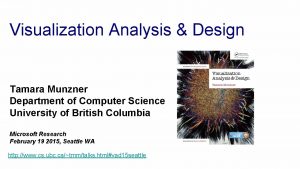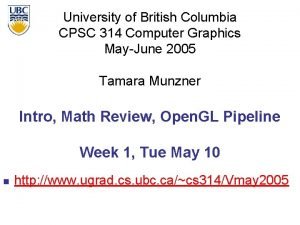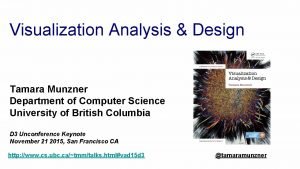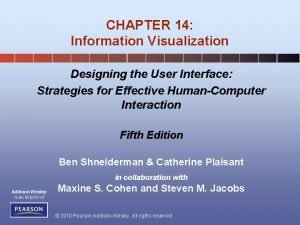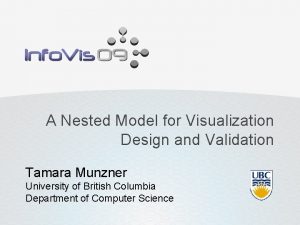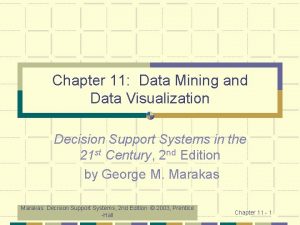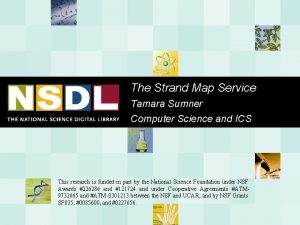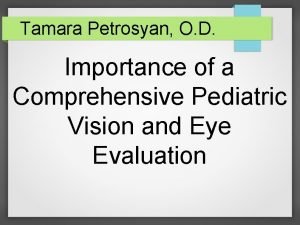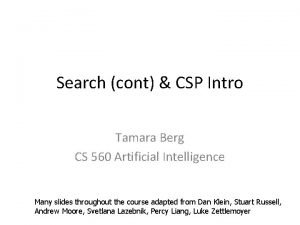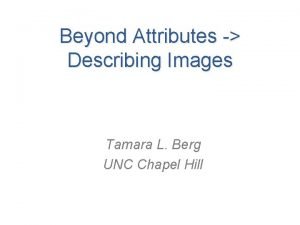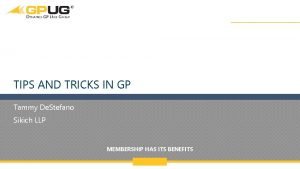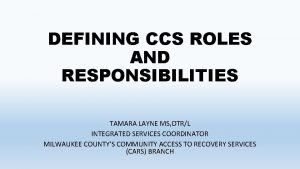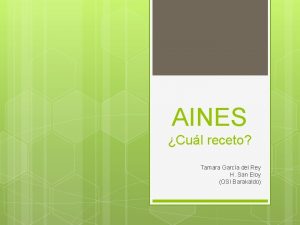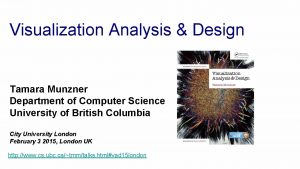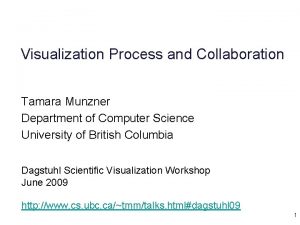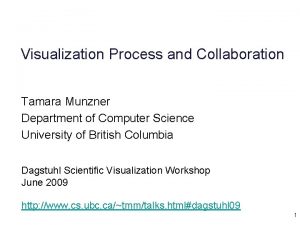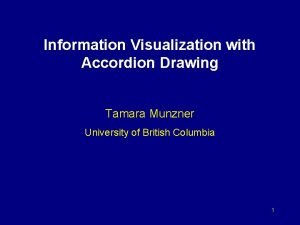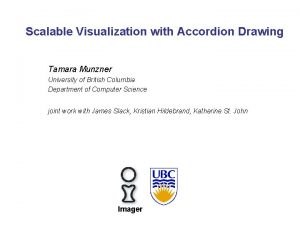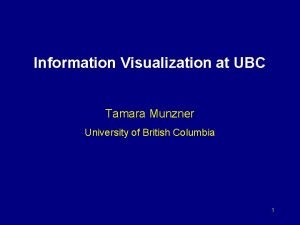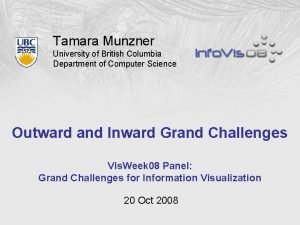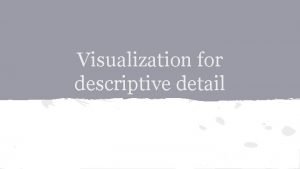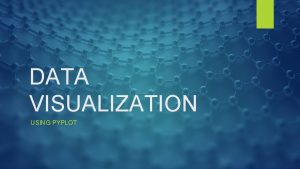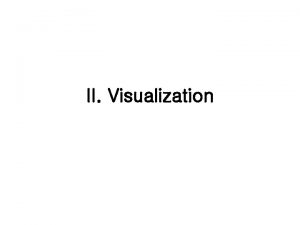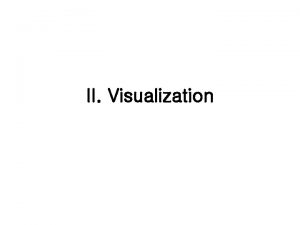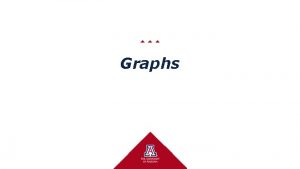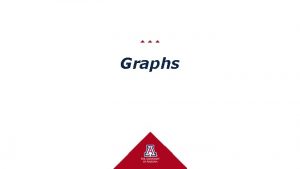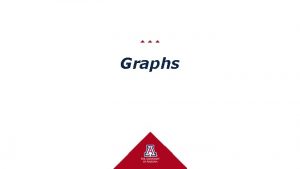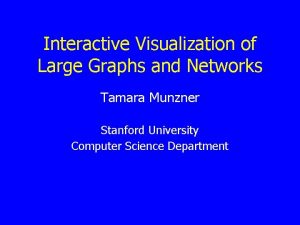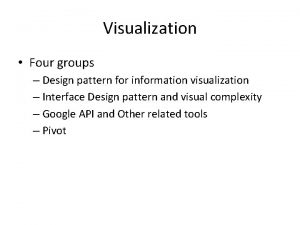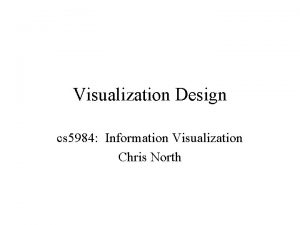Visualization Analysis Design Tamara Munzner Department of Computer














































- Slides: 46

Visualization Analysis & Design Tamara Munzner Department of Computer Science University of British Columbia Microsoft Research February 19 2015, Seattle WA http: //www. cs. ubc. ca/~tmm/talks. html#vad 15 seattle

Defining visualization (vis) Computer-based visualization systems provide visual representations of datasets designed to help people carry out tasks more effectively. Why? . . . 2

Why have a human in the loop? Computer-based visualization systems provide visual representations of datasets designed to help people carry out tasks more effectively. Visualization is suitable when there is a need to augment human capabilities rather than replace people with computational decision-making methods. • don’t need vis when fully automatic solution exists and is trusted • many analysis problems ill-specified – don’t know exactly what questions to ask in advance • possibilities – long-term use for end users (e. g. exploratory analysis of scientific data) – presentation of known results – stepping stone to better understanding of requirements before developing models – help developers of automatic solution refine/debug, determine parameters – help end users of automatic solutions verify, build trust 3

Why use an external representation? Computer-based visualization systems provide visual representations of datasets designed to help people carry out tasks more effectively. • external representation: replace cognition with perception [Cerebral: Visualizing Multiple Experimental Conditions on a Graph with Biological Context. Barsky, Munzner, Gardy, and Kincaid. IEEE TVCG (Proc. Info. Vis) 14(6): 1253 -1260, 2008. ] 4

Why represent all the data? Computer-based visualization systems provide visual representations of datasets designed to help people carry out tasks more effectively. • summaries lose information, details matter – confirm expected and find unexpected patterns – assess validity of statistical model Anscombe’s Quartet Identical statistics x mean 9 x variance 10 y mean 8 y variance 4 x/y correlation 1 5

Why are there resource limitations? Vis designers must take into account three very different kinds of resource limitations: those of computers, of humans, and of displays. • computational limits – processing time – system memory • human limits – human attention and memory • display limits – pixels are precious resource, the most constrained resource – information density: ratio of space used to encode info vs unused whitespace • tradeoff between clutter and wasting space, find sweet spot between dense and 6

Why focus on tasks and effectiveness? Computer-based visualization systems provide visual representations of datasets designed to help people carry out tasks more effectively. • what counts as effective? – novel: enable entirely new kinds of analysis – faster: speed up existing workflows • most possibilities ineffective – increase chance of finding good solutions by understanding full space of possibilities • tasks serve as constraint on design (as does data) – representations do not serve all tasks equally! 7

Analysis framework: Four levels, three questions domain • domain situation abstraction – who are the target users? idiom algorithm • abstraction [A Nested Model of Visualization Design and Validation. – translate from specifics of domain to vocabulary Munzner. of vis. IEEE TVCG 15(6): 921 -928, 2009 (Proc. Info. Vis 2009). ] • what is shown? data abstraction domain • why is the user looking at it? task abstraction • idiom • how is it shown? • visual encoding idiom: how to draw • interaction idiom: how to manipulate • algorithm – efficient computation idiom algorithm [A Multi-Level Typology of Abstract Visualization Tasks Brehmer and Munzner. IEEE TVCG 19(12): 2376 -2385, 2013 (Proc. Info. Vis 2013). ] 8

Validation methods from different fields for each level anthropology/ ethnography design computer science anthropology/ ethnography cognitive psychology • mismatch: cannot show idiom good with system timings • mismatch: cannot show abstraction good with lab study 9

Why analyze? Space. Tree. Juxtaposer • imposes a structure on huge design space – scaffold to help you think systematically about choices – analyzing existing as stepping stone to designing new [Space. Tree: Supporting Exploration in Large Node Link Tree, Design Evolution and Empirical Evaluation. Grosjean, Plaisant, and Bederson. Proc. Info. Vis 2002, p 57– 64. ] [Tree. Juxtaposer: Scalable Tree Comparison Using Focus+Context With Guaranteed Visibility. ACM Trans. on Graphics (Proc. SIGGRAPH) 22: 453– 462, 2003. ] 10

11

Dataset and data types Spatial 12

• {action, target} pairs – discover distribution – compare trends – locate outliers – browse topology 13

Actions 1: Analyze • consume – discover vs present • classic split • aka explore vs explain – enjoy • newcomer • aka casual, social • produce – annotate, record – derive • crucial design choice 14

Actions II: Search • what does user know? – target, location 15

Actions III: Query • what does user know? – target, location • how much of the data matters? – one, some, all 16

Targets 17

18

How to encode: Arrange space, map channels 19

Encoding visually • analyze idiom structure 20

Definitions: Marks and channels • marks – geometric primitives • channels – control appearance of marks 21

Encoding visually with marks and channels • analyze idiom structure – as combination of marks and channels 1: vertical position 2: vertical position horizontal position 3: vertical position horizontal position color hue 4: vertical position horizontal position color hue size (area) mark: line mark: point 22

Channels: Expressiveness types and effectiveness rankings 23

Channels: Matching Types • expressiveness principle – match channel and data characteristics 24

Channels: Rankings • expressiveness principle – match channel and data characteristics • effectiveness principle – encode most important attributes with highest ranked channels 25

30

How to handle complexity: 3 more strategies+ 1 previous • change view over time • facet across multiple views • reduce items/attributes within single view 31

How to handle complexity: 3 more strategies+ 1 previous • change over time - most obvious & flexible of the 4 strategies 32

Idiom: Animated transitions • smooth transition from one state to another – alternative to jump cuts – support for item tracking when amount of change is limited • example: multilevel matrix views – scope of what is shown narrows down • middle block stretches to fill space, additional structure appears within • other blocks squish down to increasingly aggregated representations [Using Multilevel Call Matrices in Large Software Projects. van Ham. Proc. IEEE Symp. Information Visualization (Info. Vis), pp. 227– 232, 2003. ] 33

Facet 34

How to handle complexity: 3 more strategies+ 1 previous • facet data across multiple views 35

Idiom: Linked highlighting System: EDV • see how regions contiguous in one view are distributed within another – powerful and pervasive interaction idiom • encoding: different – multiform • data: all shared [Visual Exploration of Large Structured Datasets. Wills. Proc. New Techniques and Trends in Statistics (NTTS), pp. 237– 246. IOS Press, 1995. ] 36

Idiom: bird’s-eye maps System: Google Maps • encoding: same • data: subset shared • navigation: shared – bidirectional linking • differences – viewpoint – (size) • overview-detail [A Review of Overview+Detail, Zooming, and Focus+Context Interfaces. Cockburn, Karlson, and Bederson. ACM Computing Surveys 41: 1 (2008), 1– 31. ] 37

Idiom: Small multiples • encoding: same • data: none shared System: Cerebral – different attributes for node colors – (same network layout) • navigation: shared [Cerebral: Visualizing Multiple Experimental Conditions on a Graph with Biological Context. Barsky, Munzner, Gardy, and Kincaid. IEEE Trans. Visualization and Computer Graphics (Proc. Info. Vis 2008) 14: 6 (2008), 1253– 1260. ] 38

Coordinate views: Design choice interaction • why juxtapose views? – benefits: eyes vs memory • lower cognitive load to move eyes between 2 views than remembering previous state with single changing view – costs: display area, 2 views side by side each have only half the area of one 39

Partition into views • how to divide data between views – encodes association between items using spatial proximity – major implications for what patterns are visible – split according to attributes • design choices – how many splits • all the way down: one mark per region? • stop earlier, for more complex structure within region? 40

Partitioning: List alignment • single bar chart with grouped bars – split by state into regions • complex glyph within each region showing all ages – compare: easy within state, hard across ages • small-multiple bar charts – split by age into regions • one chart per region – compare: easy within age, harder across states 41

Partitioning: Recursive subdivision System: HIVE • split by type • then by neighborhood • then time – years as rows – months as columns [Configuring Hierarchical Layouts to Address Research Questions. Slingsby, Dykes, and Wood. IEEE Transactions on Visualization 42 and Computer Graphics (Proc. Info. Vis 2009) 15: 6 (2009), 977– 984. ]

Partitioning: Recursive subdivision System: HIVE • switch order of splits – neighborhood then type • very different patterns [Configuring Hierarchical Layouts to Address Research Questions. Slingsby, Dykes, and Wood. IEEE Transactions on Visualization 43 and Computer Graphics (Proc. Info. Vis 2009) 15: 6 (2009), 977– 984. ]

Partitioning: Recursive subdivision System: HIVE • different encoding for second-level regions – choropleth maps [Configuring Hierarchical Layouts to Address Research Questions. Slingsby, Dykes, and Wood. IEEE Transactions on Visualization 44 and Computer Graphics (Proc. Info. Vis 2009) 15: 6 (2009), 977– 984. ]

How to handle complexity: 3 more strategies+ 1 previous • reduce what is shown within single view 45

Reduce items and attributes • reduce/increase: inverses • filter – pro: straightforward and intuitive • to understand compute – con: out of sight, out of mind • aggregation – pro: inform about whole set – con: difficult to avoid losing signal • not mutually exclusive – combine filter, aggregate – combine reduce, facet, change, derive 46

Idiom: boxplot • • static item aggregation task: find distribution data: table derived data – 5 quant attribs • median: central line • lower and upper quartile: boxes • lower upper fences: whiskers – values beyond which items are outliers – outliers beyond fence cutoffs explicitly shown [40 years of boxplots. Wickham and Stryjewski. 2012. had. co. nz] 47

Idiom: Dimensionality reduction for documents • attribute aggregation – derive low-dimensional target space from high-dimensional measured space 48

domain abstraction idiom algorithm 49

More Information • this talk http: //www. cs. ubc. ca/~tmm/talks. html#vad 15 seattle • book page (including tutorial lecture slides) http: //www. cs. ubc. ca/~tmm/vadbook – 20% promo code for book+ebook combo: HVN 17 – http: //www. crcpress. com/product/isbn/9781466508 910 – illustrations: Eamonn Maguire • papers, videos, software, talks, full courses http: //www. cs. ubc. ca/group/infovis http: //www. cs. ubc. ca/~tmm Visualization Analysis and Design. Munzner. A K Peters Visualization Series, CRC Press, Visualization Series, 2014. 50
 Tamara munzner data visualization
Tamara munzner data visualization Nehe opengl tutorial
Nehe opengl tutorial Visualization analysis & design
Visualization analysis & design Visualization in user interface design
Visualization in user interface design A nested model for visualization design and validation
A nested model for visualization design and validation Signal analysis and visualization
Signal analysis and visualization Market basket analysis visualization
Market basket analysis visualization What is basic computer organization
What is basic computer organization Ois2tlu
Ois2tlu Tamara sumner
Tamara sumner Tamara petrosyan
Tamara petrosyan Eight dollars are the price of a movie these days
Eight dollars are the price of a movie these days Tamara berg
Tamara berg Tamara williams nude
Tamara williams nude Tamara vance
Tamara vance Tamara mohorko
Tamara mohorko Tamara pierre louis
Tamara pierre louis Tamara hrnjacki
Tamara hrnjacki Tamara benedikt
Tamara benedikt Tamara berg unc
Tamara berg unc Tamara sołoniewicz
Tamara sołoniewicz Tamara stefano
Tamara stefano Veronica ionescu
Veronica ionescu Tamara popov
Tamara popov Woofound
Woofound Theory of translation lectures
Theory of translation lectures Tamara de lempicka young lady with gloves wikipedia
Tamara de lempicka young lady with gloves wikipedia Tamara jovanov
Tamara jovanov Tamara zappaterra
Tamara zappaterra Tamara salem
Tamara salem Tamara tovjanin
Tamara tovjanin Tamara ionescu veterinar
Tamara ionescu veterinar Martha zaslow
Martha zaslow Tamara scheffel
Tamara scheffel Tamara martirosyan
Tamara martirosyan Tamara ros
Tamara ros Tamara froese
Tamara froese Tamara nameroff
Tamara nameroff Tamara layne
Tamara layne Tamara layne
Tamara layne Tamara burke
Tamara burke Aines menos gastrolesivos
Aines menos gastrolesivos Tamara ćapeta
Tamara ćapeta Tamara berg
Tamara berg Tamara ćapeta
Tamara ćapeta Tamara berg
Tamara berg Tamara ređep
Tamara ređep
